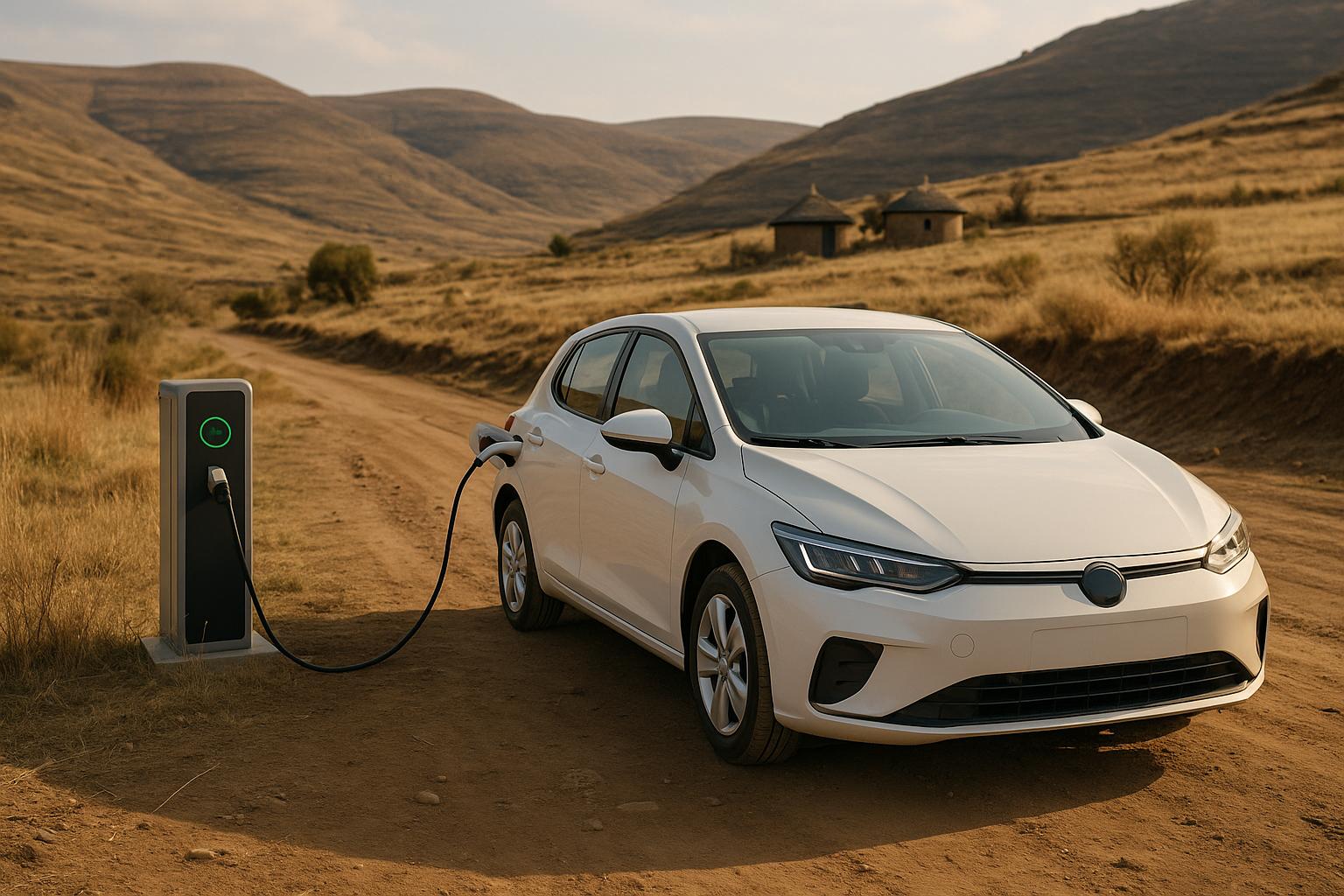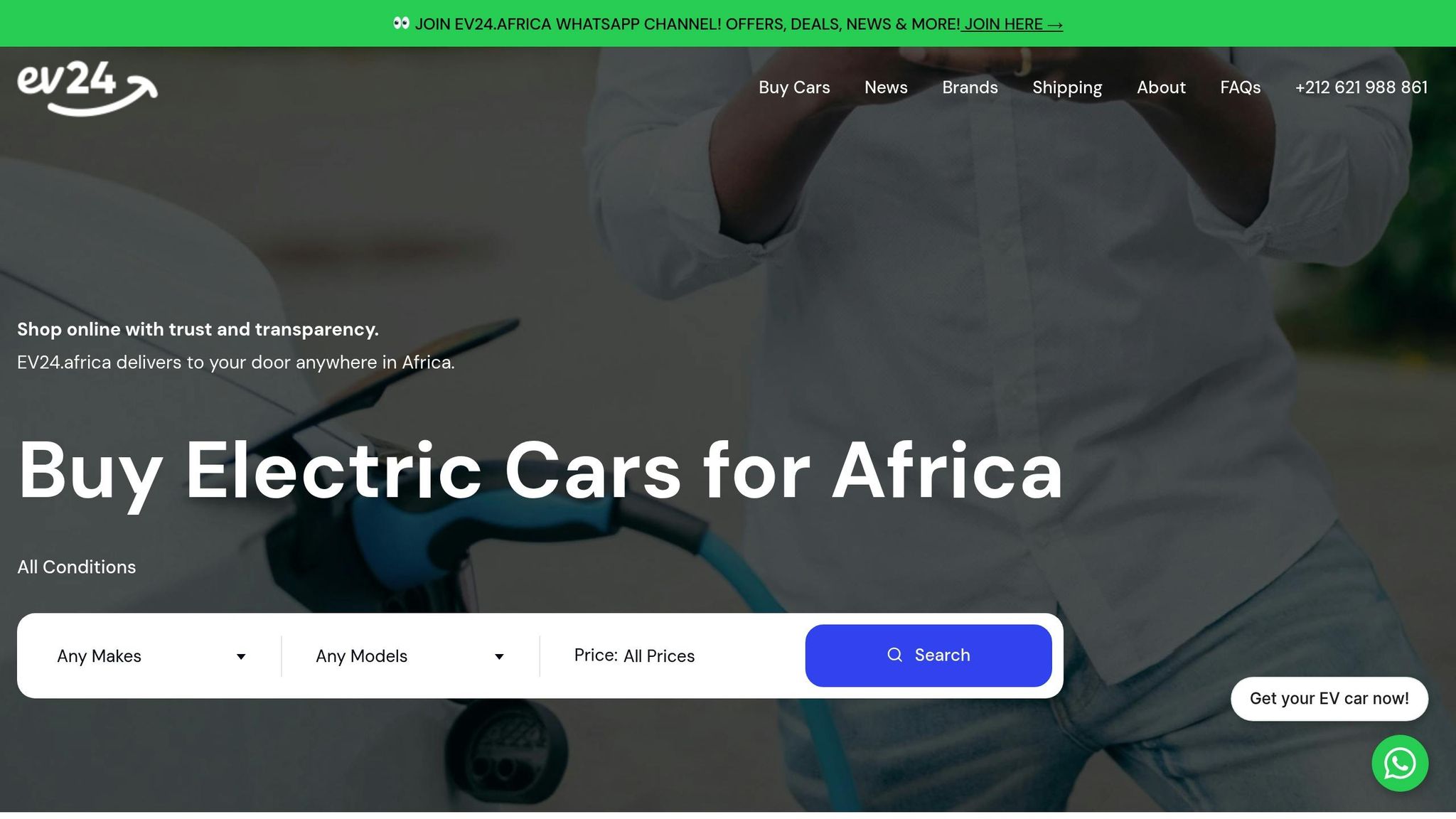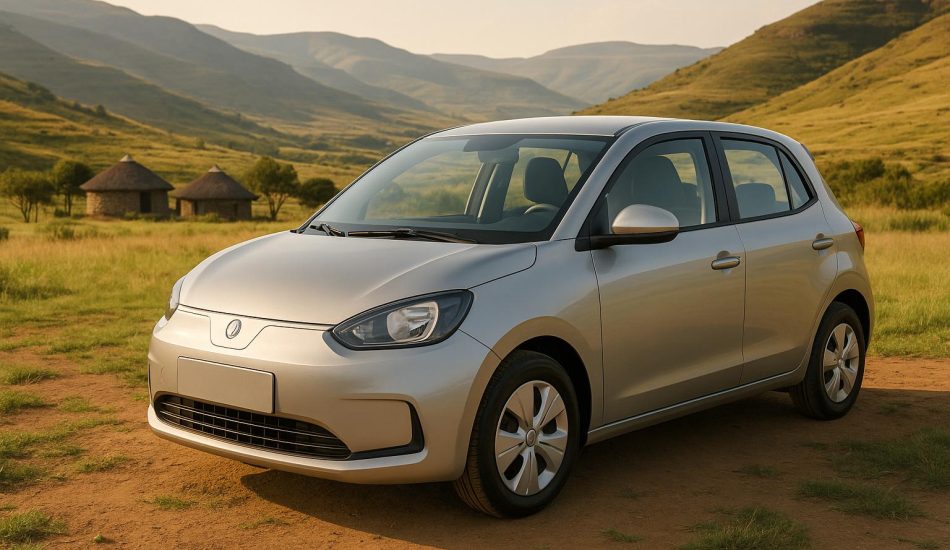
Electric cars (EVs) in Lesotho face tough challenges but show potential for growth. Here’s what you need to know:
- Charging Infrastructure: Limited public charging stations exist. Most rely on home charging, but only 57.3% of the population has electricity access, with rural areas at just 34.9%. Solar-powered solutions are emerging as a viable option.
- Road Conditions: Mountainous terrain, steep inclines, and unpaved roads reduce EV range and demand durable models with higher ground clearance and strong suspension.
- Weather Impact: Cold winters can cut battery efficiency by 20–40%. Snow and rain add to energy use and require features like all-wheel drive.
- Cost Barriers: EVs remain expensive due to import fees and limited financing options. However, upcoming tax exemptions may reduce costs by 15–20%.
- Ongoing Efforts: Initiatives like the MaZero Project are introducing solar-powered charging stations, and platforms like EV24.africa simplify EV imports and financing.
While EVs aren’t yet practical for everyone in Lesotho, urban residents and early adopters with access to charging options may find them viable. The country’s focus on renewable energy and infrastructure improvements could make EVs more accessible over time.
4 Business Strategies Changing Africa’s EV Game
Charging Infrastructure in Lesotho: Current State and Development
Lesotho took a significant step toward embracing electric vehicles (EVs) with the debut of its first electric car on November 25, 2024. This milestone, part of the EU-funded Renewable Lesotho initiative, highlights the country’s early efforts to develop its EV market and charging infrastructure.
Available Charging Options
Currently, Lesotho lacks dedicated public EV charging stations, leaving early adopters with limited options.
Home charging is the most practical solution for now, but it comes with challenges. Access to electricity remains a major hurdle, with only 57.3% of the population connected to the grid as of 2023. Urban areas fare better, with 77.7% grid access, compared to just 34.9% in rural areas. This disparity makes home charging more feasible for residents in urban hubs like Maseru, while rural areas remain largely underserved.
Workplace charging infrastructure is nonexistent, as employers have little incentive to invest in EV charging without a larger market demand. However, the arrival of the first electric car may spark interest among government bodies and larger organizations to explore such initiatives.
These limited options highlight the broader challenges Lesotho faces in establishing a reliable EV charging network.
Barriers to Expanding Charging Networks
Several factors hinder the development of a comprehensive charging infrastructure in Lesotho. Limited grid access in rural areas, coupled with an unreliable power supply, presents significant challenges. Additionally, the absence of technical standards for EV charging – such as specifications for charging stations, safety protocols, and grid integration – further complicates efforts to expand the network. Without clear guidelines, developers face uncertainty in planning and implementing charging solutions.
Future Plans for Charging Infrastructure
Although no detailed plans for expanding the charging network have been revealed, groundwork is being laid to address these challenges. Renewable energy is emerging as a key part of the solution. GET.transform, in collaboration with Lesotho’s Ministry of Energy and the Department of Energy, is working to establish regulations for both on-grid and off-grid energy systems. This initiative aims to strengthen the integration of renewable energy into the national grid, paving the way for sustainable EV charging solutions.
The EU-funded Renewable Lesotho initiative, which introduced the country’s first electric car, signals growing international interest in green transportation. This could potentially lead to additional support for developing Lesotho’s charging infrastructure.
Looking ahead, solar-powered charging stations could provide a practical and sustainable option. Lesotho’s high altitude and clear skies make it an ideal location for harnessing solar energy, offering a promising path for future infrastructure projects.
For now, efforts remain focused on creating a regulatory framework and expanding renewable energy capacity. These steps are crucial for building a charging network that can support EVs, especially given the challenges posed by Lesotho’s rugged terrain and limited grid coverage. Strengthening this infrastructure will play a critical role in enabling EV adoption and performance across the country.
Road Conditions and Terrain in Lesotho: Effects on EV Performance
Lesotho’s rugged mountains and diverse road conditions play a major role in shaping how electric vehicles (EVs) perform. These factors create unique challenges, but they also highlight the importance of choosing the right EV for the environment.
Geographic Challenges for EVs
Lesotho’s high-altitude, mountainous terrain poses a tough test for EVs. The constant changes in elevation and steep climbs demand more energy, which can significantly shorten the driving range compared to the manufacturer’s estimates. While regenerative braking helps recover energy on downhill stretches, the energy used for uphill climbs often outweighs these gains, especially on longer trips.
In cities like Maseru, paved roads offer smoother rides. But once you venture into rural areas, gravel and unpaved roads dominate, which can increase wear and tear on an EV’s suspension and undercarriage. For these conditions, EVs with a ground clearance of at least 7–8 inches are recommended.
The MaZero Project, a collaboration between Technische Hochschule Ingolstadt and the National University of Lesotho, has been putting EVs to the test in these demanding conditions. Early results show that EVs can handle daily commutes within the range of charging stations, but longer trips across rough terrain require careful planning. Beyond the terrain, weather adds another layer of complexity for EV performance.
Weather Effects on EV Performance
Lesotho’s winters, with temperatures often dropping below freezing, can reduce battery efficiency by 20–40%. Cold weather not only affects the battery but also increases energy consumption for heating the cabin. Snow and ice, common in mountainous regions, further challenge EVs by reducing traction and adding to energy use.
Seasonal heavy rains can also make certain roads harder to navigate, emphasizing the need for features like all-wheel drive and advanced traction control. These capabilities ensure EVs can handle year-round conditions, from icy winters to muddy rainy seasons.
Best EV Models for Lesotho
Not all EVs are built to handle Lesotho’s tough terrain and weather. Some models, however, stand out. For example, the Hyundai Kona Electric, with its higher ground clearance and durable construction, performs well on unpaved roads.
In general, electric SUVs and crossovers are better suited for Lesotho than sedans or hatchbacks. Features like reinforced suspension, underbody protection, and greater ground clearance make them better equipped for rough roads. For those who primarily drive in urban areas but occasionally venture into rural regions, the Nissan Leaf is a practical option. However, it’s important to note its limitations on unpaved roads and in extreme weather.
When choosing an EV for Lesotho, prioritize models with all-wheel drive, strong suspension systems, and underbody protection. These features not only enhance durability but also safeguard the battery system from damage caused by rough terrain.
The MaZero Project has shown that with the right vehicle and thoughtful planning, EVs can thrive even in challenging environments. Still, selecting the right model and considering the terrain, weather, and intended use are crucial for a smooth transition to electric mobility in Lesotho.
sbb-itb-99e19e3
Barriers to EV Adoption in Lesotho
One of the biggest obstacles to adopting electric vehicles (EVs) in Lesotho is their steep upfront cost. Import duties, taxes, and shipping fees significantly drive up prices. For instance, an EV that costs $25,000 in its country of origin can end up costing more than $30,000 by the time it reaches Lesotho. On top of that, access to specialized financing options for EV purchases is extremely limited, making it even harder for consumers to afford them. These financial challenges, combined with existing infrastructure issues, create a significant barrier to widespread EV adoption.
Solutions and Opportunities for EV Growth in Lesotho
Lesotho faces financial and infrastructure challenges when it comes to adopting electric vehicles (EVs). However, several promising initiatives are making EVs more accessible and practical for the region. From renewable energy solutions to innovative support services, these efforts are paving the way for progress.
Using Renewable Energy for Charging
Solar energy is playing a key role in boosting EV charging reliability in Lesotho. A standout example is the MaZero Project, launched in April 2025. This initiative, a collaboration between the National University of Lesotho’s Energy Research Centre, Technische Hochschule Ingolstadt, and Technologies for Economic Development, has introduced solar-powered charging stations at university campuses in Roma and the Institute of Extra Mural Studies. These stations are tailored to local conditions, helping reduce dependence on the national grid, cut greenhouse gas emissions, and stabilize energy supply.
Another charging station is under construction at the Renewable Lesotho main office, with plans to eventually open it to the public. Meanwhile, home solar charging kits are providing EV owners with an independent and cost-effective way to charge their vehicles, addressing grid reliability issues and lowering long-term expenses.
How EV24.africa Supports EV Adoption

EV24.africa is making the transition to electric vehicles easier by offering a range of support services. The platform simplifies importing EVs by providing options for vehicle selection, financing, and delivery. Their comprehensive approach includes both RoRo (Roll-on/Roll-off) and container shipping, as well as port-to-port or door-to-door delivery. Full assistance with customs clearance and local registration ensures a smooth process for buyers, even in regions with logistical challenges.
The platform offers a variety of EV models to fit different budgets, from the GEELY PANDA MINI BASE priced at $5,880 to the BYD TANG EV 2024 at $34,700. Operating across all 54 African markets and providing customer support through WhatsApp, EV24.africa ensures Lesotho’s buyers receive personalized service and continued support.
New Technology Solutions
Technological advancements are addressing key challenges like range anxiety and performance in tough environments. Innovations such as improved battery efficiency, wireless and ultra-fast charging, and mandatory technician training are helping EVs perform better in Lesotho. These solutions, combined with supportive government policies, are crucial for overcoming local obstacles.
Starting in 2025, the government plans to eliminate VAT and customs duties on EVs, potentially reducing prices by 15–20%. Additionally, public charging stations are being rolled out at locations like Maseru Mall and Pioneer Mall, with solar-powered stations also planned for Berea and Leribe districts. These efforts highlight a growing commitment to making EVs a viable option, even in areas with grid limitations and challenging terrain.
These combined measures are helping Lesotho move closer to a future where electric vehicles are a practical and sustainable choice for its residents.
Conclusion: Are EVs Practical in Lesotho?
Electric vehicles (EVs) come with their fair share of hurdles in Lesotho, but there are glimmers of hope that suggest a gradual shift is possible.
The challenges are clear: steep terrains, limited charging infrastructure, an unreliable power grid, and the high initial costs of EVs make adoption a tough sell. On top of that, the regulatory landscape is still evolving, adding another layer of complexity for those considering the switch to electric mobility.
However, Lesotho’s natural advantages offer some promising opportunities. The country’s abundant sunshine makes solar charging a viable option, and its relatively small urban areas help alleviate concerns about driving range for city dwellers. These factors create space for service providers to step in and address the gaps.
For early adopters, particularly those in urban areas, EVs are becoming a more realistic option. Companies like EV24.africa are simplifying the process, offering straightforward pricing, financing options, and delivery support to help buyers navigate this emerging market.
While EVs may not yet be the perfect fit for everyone in Lesotho, the future looks brighter. Improvements in infrastructure, declining costs, and a growing focus on renewable energy are paving the way for wider adoption. The extent to which EVs can thrive in Lesotho will depend on continued innovation and supportive government policies.
For now, anyone considering an electric vehicle should weigh their options carefully, factoring in charging availability and how well the local infrastructure aligns with their driving habits. Transitioning to electric mobility is a journey, and for Lesotho, that journey is just beginning.
FAQs
Can electric vehicles in Lesotho rely entirely on solar-powered charging stations given the current infrastructure and road conditions?
Relying entirely on solar-powered charging stations for electric vehicles (EVs) in Lesotho presents some hurdles, though it’s not out of reach. Lesotho enjoys plenty of sunshine, which is ideal for solar energy. However, the current infrastructure for solar charging is sparse, especially in rural areas. This lack of widespread access makes it tough for EV owners to travel long distances or rely on their vehicles consistently without a significant push to expand solar networks.
On top of that, Lesotho’s rugged terrain and unpredictable road conditions add another layer of complexity, particularly for EV use in remote areas. That said, advancements in solar technology and efforts to enhance infrastructure could make solar-powered EV charging more feasible down the line. For now, a mix of solar and grid-based charging solutions might be the most practical option for EV users navigating the country’s unique challenges.
Which electric vehicles are best suited for Lesotho’s tough terrain and changing weather?
For the rugged landscapes and unpredictable weather of Lesotho, electric SUVs such as the BYD Shark, Geely RD6 EV, Changan Hunter, and Foton G9 EV stand out as excellent options. These vehicles are built to tackle tough roads while offering reliability and energy efficiency.
Another strong contender is the Riddara 4WD, which features an all-electric four-wheel-drive system. This makes it particularly well-suited for handling uneven terrain and steep climbs. These models blend cutting-edge technology with sturdy construction, perfectly suited for the challenges of Lesotho’s unique conditions.
How will government tax breaks and renewable energy programs affect the cost and adoption of electric vehicles in Lesotho?
Government tax incentives and renewable energy programs could play a major role in making electric vehicles (EVs) more accessible in Lesotho. Cutting import taxes or introducing financial incentives would lower the upfront cost of EVs, making them a more realistic option for the average driver.
At the same time, renewable energy projects like solar and wind power could improve access to dependable charging stations. This would make owning an EV more convenient while also supporting global goals to cut carbon emissions. Combined, these efforts could speed up Lesotho’s transition to electric mobility.




